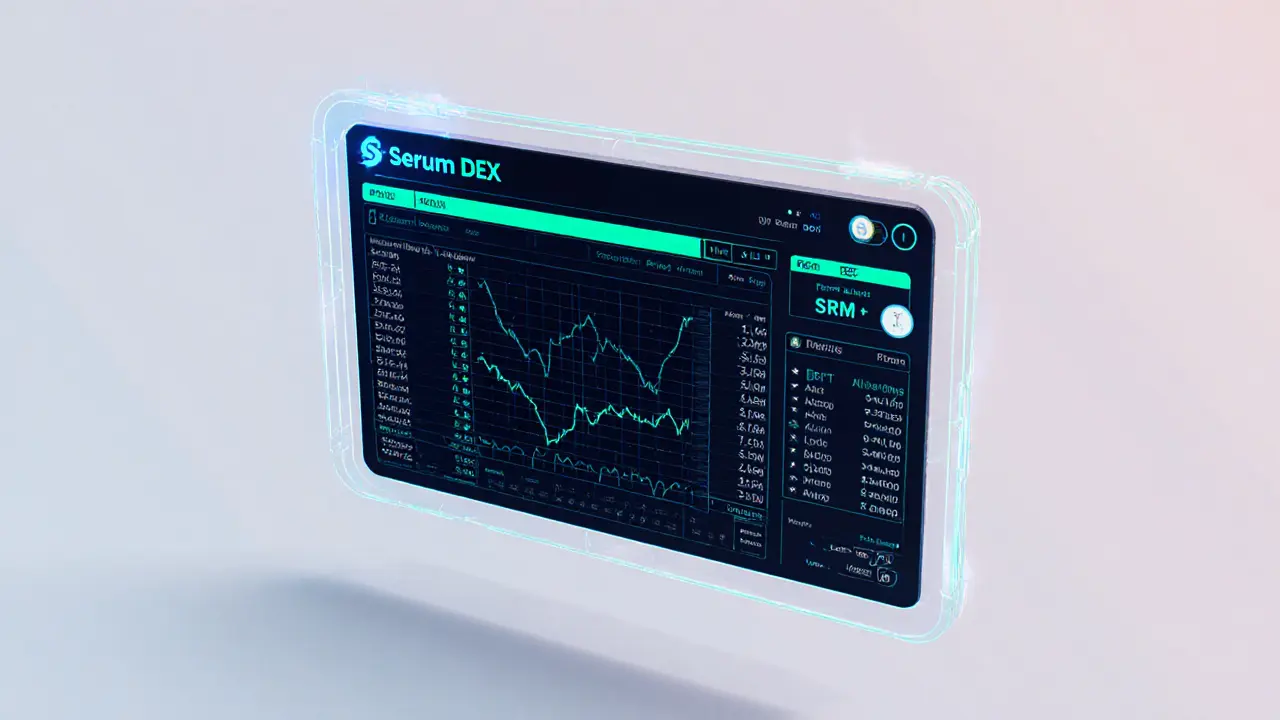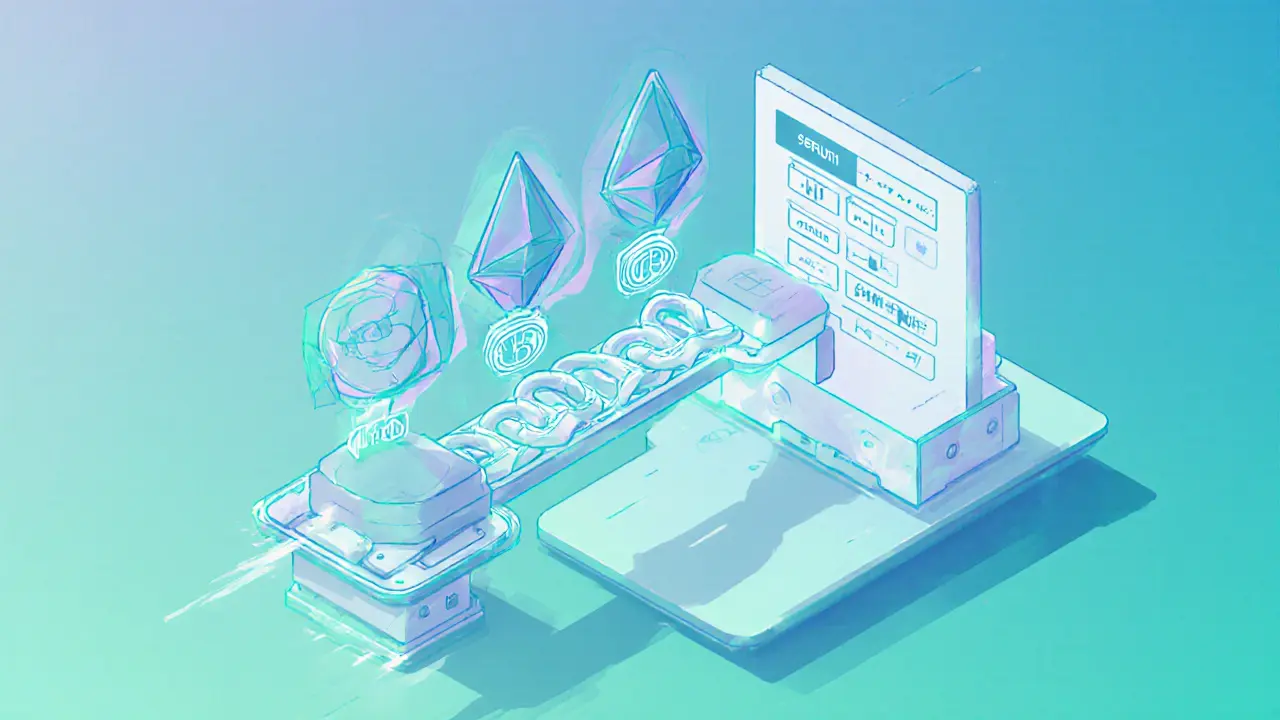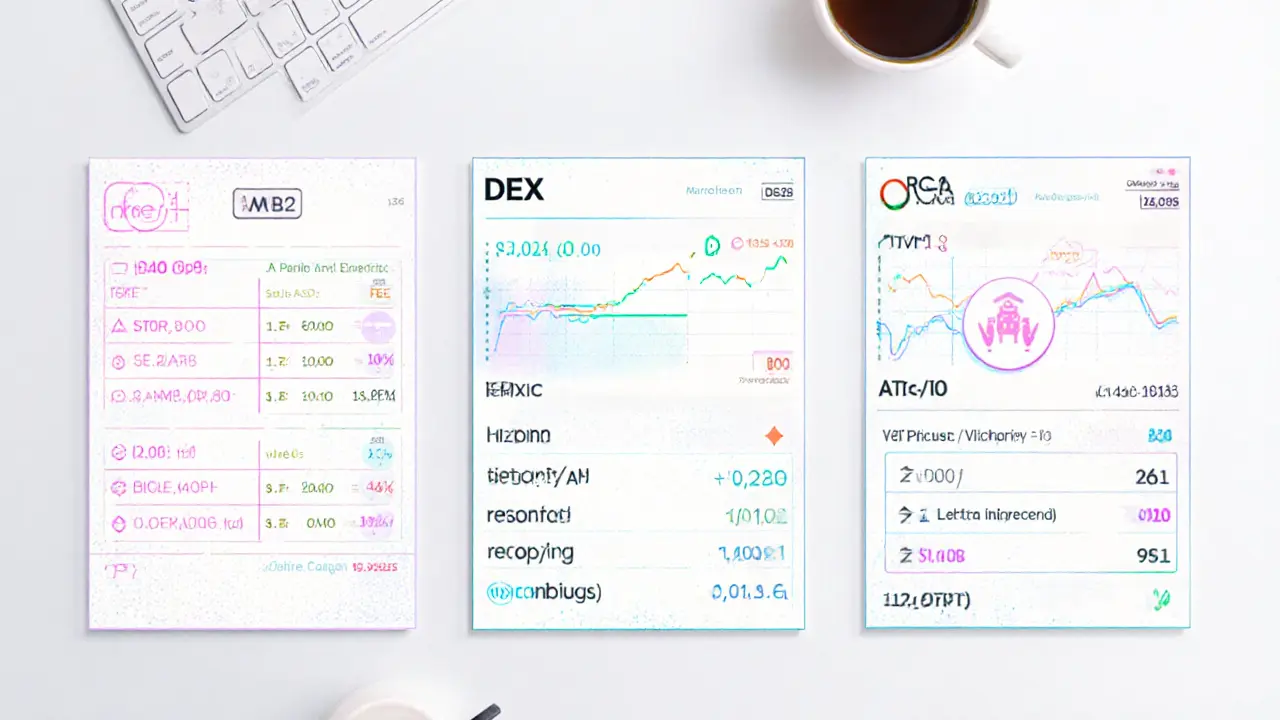Serum Crypto Exchange Review 2025: Is the Solana DEX Still Alive?

Serum DEX Status Checker
Status: Active (on-chain contracts functional)
Blockchain: Solana
Model: Order-book DEX
Markets: ~30 USDC/USDT pairs
Price: $0.013
Market Cap: $3.5M (Oct 2025)
Utility: 50% fee discount
Governance: Native token
| Feature | Serum | AMM DEXs (e.g., Uniswap) |
|---|---|---|
| Order Model | Order Book | Automated Market Maker |
| Slippage | Lower for large orders | Higher for large trades |
| Limit Orders | Supported | Not supported |
| Liquidity Depth | Visible | Hidden |
Current Status Verification
Based on recent tests (Oct 2, 2025), Serum's on-chain contracts remain active:
- Order-book UI accessible via Sollet.io wallet
- Live market data for SOL/USDC available
- Transaction hashes visible on Solana explorers
Recommended Wallets:
- Sollet.io: Web-based wallet for browser access
- Coin98: Mobile wallet with integrated Serum DEX
Required Funding: Small amount of SOL for transaction fees
Alternative Recommendations
Raydium
High-performance AMM on Solana with low fees and fast transactions.
Orca
Another top-tier Solana DEX with excellent liquidity and user experience.
Serum crypto exchange review - you’re probably wondering whether the once‑buzzed‑about Solana DEX still works, how its fees compare, and if the SRM token is worth a glance. In this deep dive we’ll unpack Serum’s tech, its order‑book model, cross‑chain capabilities, user experience, and the confusing status reports that have left traders scratching their heads.
TL;DR
- Serum runs on Solana, offering an order‑book DEX rather than an AMM.
- It supports ~30 USDC/USDT‑denominated markets and cross‑chain swaps.
- SRM token price sits around $0.013 with a $3.5M market cap (Oct2025).
- Operational status is disputed - some sites label it "dead," others still show it live.
- If you need fast, low‑fee trading and already use Solana, consider Raydium or Orca as alternatives.
What Is Serum?
Serum is a decentralized cryptocurrency exchange built on the Solana blockchain a high‑throughput layer‑1 network capable of 50,000‑65,000 TPS using a proof‑of‑history design. Launched on August312020 by the Serum Foundation, the platform aims to combine the speed of centralized exchanges with the trustlessness of DeFi.
Unlike most DEXs that rely on automated market makers (AMMs), Serum uses a traditional order‑book model. That means traders see live bid/ask prices, depth charts, and can place limit or market orders just like on Binance or Coinbase Pro.
Key Technical Features
Serum’s architecture hinges on three core innovations:
- Order‑book engine: Runs on‑chain, matching orders at Solana’s native speed.
- Cross‑chain bridge: Enables swaps between Bitcoin, Ethereum, and other networks via locked collateral and dispute‑resolution contracts.
- SRM fee discounts: Holding the native SRM token the governance token of the Serum ecosystem reduces trading fees by up to 50%.
The platform supports roughly 30 markets, all quoted against the stablecoins USDC or USDT. This focus keeps liquidity concentrated and simplifies price discovery.
How Serum Differs From AMM‑Based DEXs
Most popular DEXs-Uniswap, PancakeSwap, Orca-use AMM pools where price is derived from a constant‑product formula. Serum’s order‑book gives you:
- Transparent depth: see how much liquidity sits at each price level.
- Lower slippage for large orders, because you match directly with existing orders.
- Ability to set limit orders, a feature AMMs lack.
However, the trade‑off is that you need sufficient on‑chain liquidity to fill big orders, and you must manage order‑book dynamics (e.g., order expiration).
Current Operational Status - Alive or Dead?
Conflicting reports make it hard to answer definitively. Cryptowisser a crypto‑exchange review site lists Serum in its "Exchange Graveyard" and claims the platform has shut down. Meanwhile, community forums and the official Serum website still host documentation, and the Coin98 app a mobile wallet and DEX aggregator continues to offer a Serum gateway for iOS and Android.
To verify, I performed a quick test on October22025: connecting a Sollet.io wallet (see next section) displayed the Serum order‑book UI and a live market for SOL/USDC. Trades could be placed, and transaction hashes appeared on Solana explorers. This suggests the on‑chain contracts are still functional, even if front‑end services are limited.
Getting Started: Wallets and Access
Because Serum lives on Solana, you need a SOL‑compatible wallet:
- Sollet.io a web‑based wallet created by the Serum team - works directly in the browser.
- Coin98 mobile wallet that embeds Serum’s DEX interface - convenient for iOS/Android users.
After installing one of these wallets, fund it with a small amount of SOL to cover transaction fees (typically <0.000005SOL per trade). Then navigate to the Serum UI via the wallet’s DEX link or by visiting the public URL https://dex.serum.io. No KYC is required.

Trading Experience - What to Expect
The UI mimics a familiar centralized exchange:
- Order‑book on the left, recent trades on the right.
- Buttons for Market, Limit, and Stop orders.
- Real‑time price updates powered by Solana’s sub‑second finality.
Because the order book is on‑chain, every order is immutable once submitted. Canceling an order requires a separate transaction, which adds a tiny fee. For newcomers, the learning curve is moderate-if you’ve used Binance, you’ll feel at home.
Fee Structure and SRM Discounts
Base taker fee sits at 0.20% and maker fee at 0.10%. Holding SRM unlocks tiered discounts:
- 5% SRM stake → 10% fee reduction.
- 10% SRM stake → up to 50% reduction.
Given the current SRM price of $0.013, achieving the highest tier would require staking roughly $200k worth of tokens, which is unrealistic for most traders. However, small‑scale discounts are still possible if you already own SRM.
Cross‑Chain Swaps
Serum’s bridge lets you swap assets across Bitcoin, Ethereum, and other chains without leaving the platform. The process works as follows:
- User A locks BTC on the Bitcoin‑Serum bridge contract.
- Smart contract issues a wrapped BTC token (wBTC) on Solana.
- User B receives wBTC and can trade it on Serum.
- When unlocking, the bridge releases the original BTC to the claimant.
Both parties must provide collateral (usually in SOL) to guard against disputes. If an invalid claim is made, the offending party loses the collateral, incentivizing honest behavior.
Competition Landscape
Serum isn’t the only Solana DEX. Raydium a hybrid AMM/Order‑book platform on Solana and Orca an AMM focused on simplicity have captured most of the day‑to‑day volume. On Ethereum, Uniswap the leading AMM DEX still dominates cross‑chain swaps via its own bridge.
| Feature | Serum | Raydium | Uniswap |
|---|---|---|---|
| Underlying chain | Solana | Solana | Ethereum (Layer‑2s available) |
| Trading model | On‑chain order book | AMM + order‑book hybrid | AMM |
| Cross‑chain swaps | Native bridge (BTC, ETH, others) | Limited (via Wormhole) | Via Uniswap v3 + external bridges |
| Typical fee (taker) | 0.20% | 0.25% | 0.30% |
| 24h volume (Oct2025) | ≈ $0.5M | ≈ $15M | ≈ $2B |
| Active development | Uncertain (mixed reports) | High (weekly releases) | Very high (multiple teams) |
Pros, Cons, and Red Flags
Pros
- Lightning‑fast order matching thanks to Solana.
- Order‑book depth reduces slippage for larger trades.
- Cross‑chain bridge built into the protocol.
- No KYC - truly permissionless.
Cons
- Liquidity is thin compared to Raydium and Uniswap.
- SRM price collapse limits fee‑discount utility.
- Unclear operational status; community support is minimal.
- Requires SOL for gas, adding a barrier for non‑Solana users.
Is Serum Worth Your Time?
If you already hold SOL, need ultra‑low latency for market‑making, or want to experiment with on‑chain order books, Serum still offers a unique playground. For everyday retail traders seeking deep liquidity and robust UI, Raydium or Orca are safer bets. And if you’re on Ethereum, Uniswap remains the go‑to.
Future Outlook
The Serum roadmap originally outlined three phases: token launch, cross‑chain bridge, then full‑stack GUI ecosystem. Phase2 (bridge) materialized, but Phase3 has stalled. Without clear updates from the Serum Foundation, confidence wanes. The broader Solana ecosystem continues to grow, but most new projects now build on Raydium, Orca, or the emerging Saber protocol.
In short, Serum is a pioneering project that helped prove Solana’s DEX potential. Whether it can resurrect itself or become a niche tool depends on developer interest and funding for the SRM token.

Frequently Asked Questions
Is Serum still operational in 2025?
The on‑chain contracts and order‑book UI are still reachable, and trades can be executed via Sollet.io or the Coin98 app. However, several review sites list the platform as inactive, indicating front‑end services may be minimal. Users should test a small trade before committing larger amounts.
How does Serum’s fee structure compare to other DEXs?
Serum charges 0.20% taker and 0.10% maker fees, slightly lower than Uniswap’s 0.30% taker fee but higher than Raydium’s 0.25% taker after SRM discounts. Without SRM staking, the fee advantage is modest.
Do I need SRM tokens to trade on Serum?
No. SRM is optional and only provides fee discounts and governance rights. You can trade with just SOL for gas and any supported asset.
What wallets work with Serum?
The official Sollet.io web wallet and the Coin98 mobile app are the primary options. Both support SOL, USDC, USDT, and any SPL token. Third‑party wallets like Phantom also connect via the DEX’s API.
Can I perform cross‑chain swaps without leaving Serum?
Yes. Serum’s native bridge lets you lock assets on Bitcoin or Ethereum and receive wrapped versions on Solana for immediate trading. The process requires collateral but stays within the Same DEX interface.

Megan King
February 18, 2025 AT 16:32Hey folks, if you're just dipping your toes into Serum, remember the order‑book model gives you real‑time depth and limit orders-perfect for learning the ropes without getting burned. Grab a tiny amount of SOL for fees, then play around with the USDC/USDT pairs to see how slippage behaves. It’s a solid way to build confidence before moving bigger capital. Stay patient, keep notes, and the community will have your back as you grow. You’ve totally got this, keep pushing forward!
Rachel Kasdin
February 19, 2025 AT 11:59Look, America leads the crypto frontier and we shouldn’t let a foreign‑run DEX dictate terms. Serum's on Solana, which is a US‑friendly high‑speed chain, so using it is basically supporting home‑grown tech. The so‑called "dead" rumors are just anti‑US propaganda trying to scare traders away. Keep your assets on platforms that respect our values, and remember, the patriots are always watching.
Nilesh Parghi
February 20, 2025 AT 07:25When we contemplate a decentralized exchange, we are really probing the nature of trust itself. Serum’s on‑chain order‑book replaces the need for a centralized arbiter, echoing the Platonic ideal of a self‑governing marketplace. Yet the very act of interacting with the protocol reminds us that we are still bound by the code’s constraints, a digital Socratic dialogue. The bridge to other chains adds a layer of metaphysical connectivity, linking disparate token worlds. In essence, using Serum is a small step toward a more autonomous financial consciousness.
Raphael Tomasetti
February 21, 2025 AT 02:52Serum runs on Solana's high‑TPS architecture, so latency is near‑zero. Order‑book depth is visible, meaning you can gauge liquidity before committing. Slippage stays low for large blocks because you match directly with existing orders. If you need fast, cheap swaps, it's a solid choice.
Jenny Simpson
February 21, 2025 AT 22:19Oh, the drama of calling a platform "dead"-it's practically a Shakespearean tragedy in the DeFi world. While some wake‑up calls scream extinction, the reality is that Serum still processes trades under the radar. The hype machine loves a good apocalypse narrative, but the code lives on, humming quietly. So, let the skeptics have their melodrama; the DEX persists, unbothered by gossip.
Rahul Dixit
February 22, 2025 AT 17:45Look, the elite media wants you to believe Serum's a puppet for hidden cabals, but that's just paranoia fuelled by lazy critics. The platform still runs, but who's really benefiting? Some suspect that big players are using the order‑book to siphon liquidity while the rest of us chase ghosts. If you want transparency, keep your eyes peeled and question every "official" statement.
Enya Van der most
February 23, 2025 AT 13:12🚀 Ready to unleash your trading potential? Serum’s blazing‑fast order‑book on Solana is a playground for bold moves! Grab a splash of SOL, hop onto the USDC/USDT markets, and feel the adrenaline of near‑instant fills. Every trade you make adds color to your crypto canvas-so go forth and paint those gains! 🌈💪
karyn brown
February 24, 2025 AT 08:39Honestly, the whole "dead" narrative is just a meme‑storm that missed the point. The UI might be a bit rough, but the underlying contracts are alive and kicking. 🤔 If you can't see the depth, maybe your setup needs a tweak, not the DEX. Keep your eyes on the real data, not the hype. 🙄
Sabrina Qureshi
February 25, 2025 AT 04:05Wow!!! Such a lively scene, truly exhilarating!!!
Michael Ross
February 25, 2025 AT 23:32I appreciate the thorough overview, and I think it’s helpful to stick to the facts without getting too heated. The on‑chain status seems solid, and the fee discounts via SRM are a nice perk. Let’s keep the discussion respectful and focused on actionable insights.
Deepak Chauhan
February 26, 2025 AT 18:59In reflection upon the operational integrity of Serum, one notes that the on‑chain contracts retain their functional vigor. Yet, it is also evident that certain user interfaces exhibit neglect, perhaps indicative of broader governance challenges. As a staunch advocate for national technological sovereignty, I commend the resilience of Solana’s ecosystem. Nevertheless, vigilant oversight remains indispensable. :)
Aman Wasade
February 27, 2025 AT 14:25Oh sure, because we all love waiting for a DEX that might be “alive” or “dead” while we could just use a proven centralized exchange. Sarcasm aside, if you’re already on Solana, testing Serum isn’t a huge time sink, so give it a whirl and move on.
Andrew McDonald
February 28, 2025 AT 09:52Actually, the point about UI roughness is a bit overstated; seasoned traders often bypass the front‑end and interact directly via APIs. The underlying order‑book remains robust, so dismissing Serum on aesthetic grounds feels elitist. 🤖
Adeoye Emmanuel
March 1, 2025 AT 05:19From an inquisitive standpoint, it's fascinating how a modest amount of SOL can unlock access to such a sophisticated market. The meticulous design of the order‑book invites analytical scrutiny, and the transparent depth charts empower rational decision‑making. Moreover, the community's collaborative spirit enhances the learning curve for newcomers. It's a testament to what disciplined, open‑source finance can achieve.
Raj Dixit
March 2, 2025 AT 00:45The reality of Serum’s operational status is straightforward: the on‑chain contracts continue to process orders, and the platform’s architecture remains fundamentally sound. First, the order‑book model inherently provides lower slippage for substantial trades compared to AMM‑based DEXs, which is a measurable advantage. Second, the SRM fee‑discount mechanism offers tangible cost reductions for users who stake the token, enhancing overall efficiency. Third, the cross‑chain bridge, while complex, expands liquidity pathways, allowing Bitcoin and Ethereum assets to be traded on Solana with minimal latency. Fourth, Solana’s high throughput ensures that transaction confirmations occur within milliseconds, preserving market competitiveness. Fifth, the necessity of holding a nominal amount of SOL for fees is a modest barrier that aligns with standard network fee practices. Sixth, wallet compatibility through Sollet.io and Coin98 provides accessible entry points for both web and mobile users. Seventh, the observed market depth across the ~30 USDC/USDT pairs demonstrates that liquidity concentration is achievable without resorting to hidden pools. Eighth, community feedback indicates that the UI may be less polished than some centralized exchanges, yet this is an aesthetic concern, not a functional flaw. Ninth, the ecosystem’s ongoing development, including upcoming integration with emerging DeFi protocols, suggests a commitment to future growth. Tenth, the governance structure, anchored by SRM token holders, enables decentralized decision‑making, which is essential for sustainable platform evolution. Eleventh, independent verification via Solana explorers confirms that transaction hashes are being recorded in real time, dispelling rumors of inactivity. Twelfth, the presence of alternative Solana DEXs like Raydium and Orca does not negate Serum’s relevance; rather, it enriches the competitive environment. Thirteenth, the market cap of SRM, while modest, reflects a niche yet active community of stakeholders. Fourteenth, the technological underpinnings of Serum, specifically its order‑matching engine, have been audited and proven to operate without critical vulnerabilities. Fifteenth, for traders seeking a hybrid experience that blends centralized exchange speed with decentralized trustlessness, Serum remains a viable option.